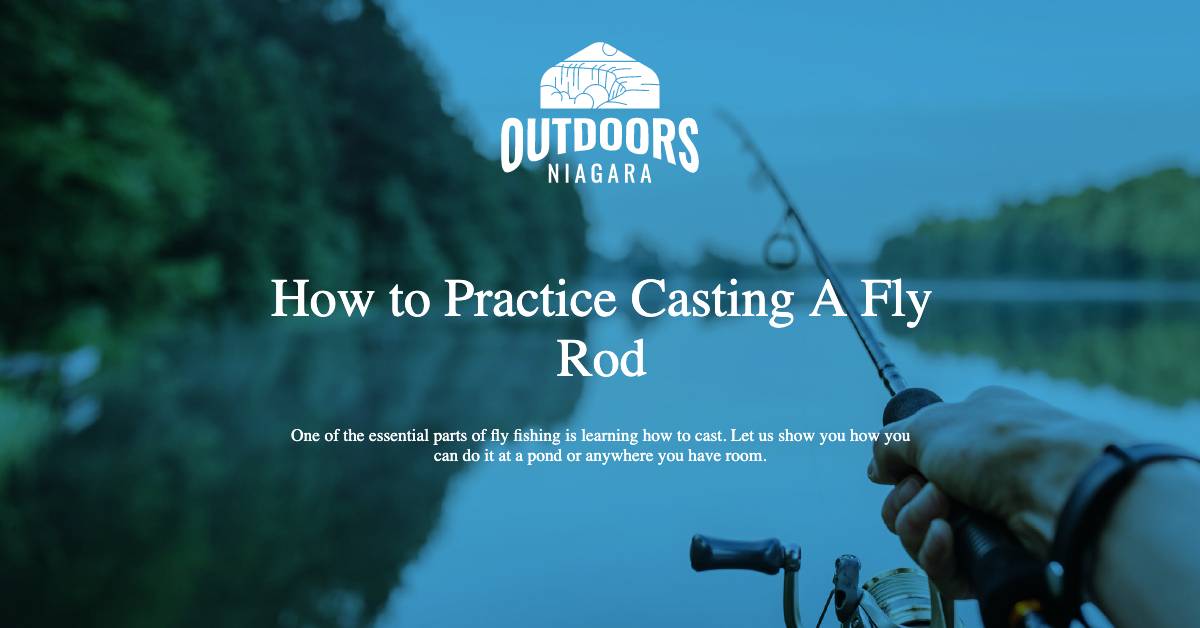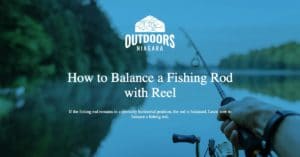One of the essential parts of fly fishing is learning how to cast.
The process is a little technical, and the key to becoming proficient at casting with a fly rod is to practice.
Inside this blog, we will go over how you practice a fly rod for casting and include information for different environments.
Contents
Where can I practice fly casting?
You can practice fly casting almost anywhere. Of course, the best place is a river, but you can set up a practice area on the lawn, at a park, or pond.
A lot of anglers practice fly-casting at home in their backyard.
What is essential is that there is plenty of room in front of you and behind you.
Also, be sure that there are no overhead power lines.
You also want to practice casting when others are not nearby.
A good tip for practicing is to remove the hook from the fly and add a split shot with the same weight as the hook.
How to Practice Fly Casting at A Casting Pond
A casting pond is just a pond without a lot of trees or shrubs around it. These make an ideal place to learn to cast flies for a variety of reasons that include:
- You can practice in a natural environment where the ground is uneven, standing in water, or even from a boat or kayak.
- You can cast in various conditions, such as uneven ground, standing in water, or even from a boat or kayak. The changing environment will challenge you.
- You can focus on technique so that you can deal with changing environments while you fish.
- You can face minor but genuine obstacles while you cast.
How do you practice at a casting pond? Here’s how we do it.
- Gather your rod and flies and saddle up to the pond.
- Check the surrounding environment. Note any trees, shrubs, or other obstacles. Make sure nobody else is around and that you are not near your vehicle.
- Double-check your fly rod, line, and fly to make sure it is ready for use.
- Let the fly dangle out into the water and pull off a few yards of line from the reel. Not too much, or it will tangle or knot. A yard or two is enough.
- Hold the line where just below the first eye and above the reel. Also, let the bit of line that is off the real is loose. That bit of line off the reel will feed the length of line you have for casting. Fly-fishing casts out and back and out and back, and each time it heads out over the pond, you feed it slackline. As you do this, the length of the line in the cast grows. We do this because the drag on your reel should be set to handle a fish, and as such, it will not release the line.
- The motion of casting is straight overhead. Think of a clock face. Back is 2 PM and forward is 10 PM. Those positions are as far as you move your arm and wrist. Hold your pole straight up move it forward to the 10 PM position. Please bring it back to the 2 PM position. That movement you can practice at home without the fly rod.
- Lean the pole forward to the 10 PM spot when you are ready to start casting and yank backward to the 2 PM position. What should happen; the fly will come out of the water and fly over your head. As soon as you hit the 2 PM position and the fly is behind you, snap the rod forward to the 10 PM position. As you do, loosen the grip on the line you are holding. As the fly passes out over the pond, it will take some line with it. As it takes line, snap the pole back to the 2 PM position and tighten up on the line you are holding. That is the rhythm you need to master to get the line out far enough to target fish. When the pool of excess line is running out, on the backstroke to the 2 PM position, gently pull out some more line with your free hand.
As you get better at casting, you will keep the line directly over the pole and the pole straight up, not waving left or right.
You also want to be able to look behind you while you are casting to see what the line is doing.
Finally, you can evaluate the loop, which is the place where the line overlaps itself in the air.
The loop should remain flat rather than circular.
Casting sounds easy, but it is a very complex set of actions. Practice a lot, and you will master this in no time.
How to Practice Fly Casting on Grass
The technique for casting is the same as above. What changes from the pond to casting on grass is that you lose the hook. Replace the hook with a small split-shot that weighs the same as the fly. You always approach casting a fly rod the same.
- Stop and examine your environment. Make sure nobody is nearby, that there are no overhead trees or power lines. Casting when tree limbs are overhead can break the tip of your fly rod.
- Follow the steps above. The 10 and 2 clock position is the goal.
- Be sure to monitor what you are doing. Make sure the rod stays completely vertical without any lean to the left or right. The line will follow the pole, and you want the line to remain overhead.
- Practice tossing the fly at various lengths of the grass field. Set up little markers that show you how far out the line is. Not every fishing hole is 500 meters out from where you cast. Some are just a few dozen yards. Practicing on grass allows you to adjust your casting for different distances.
How to Practice Fly Casting at Home
It is challenging to practice casting at home.
So what you do instead is practice the 10 and 2 positions while releasing line from the real.
If your fly rod comes in two pieces, you can use the bottom piece for this.
It may surprise you that professional fly fishers practice this rhythm every day.
However, once you get down the 10 and 2 rhythm and you master letting line out at the same time, your fly-fishing and casting will improve significantly.
How Do You Practice Fly Casting in Your Backyard
Backyard practice for tossing flies is also challenging.
Unless your backyard is like a vast park, you will need to focus on short casting techniques.
Like everywhere else, start investigating your environment.
Look for overhead power lines, windows, trees, and other obstacles.
Use an old fly that won’t break your heart if you lose it.
Take a pair of wire cutters, and cut the hook off, leaving about 1/2 inch of the shank.
To the shank, apply a small split shot.
The goal here is to practice short casts. You will be in spots where you can not do long casting because of overhead trees and brush.
You may also be in a situation where you need to sight cast at a target.
Get the 10 and 2 rhythm down and keep your casting to 20 feet.
Could I Use A Dry Fly Casting Practice Rod?
There is no need to buy a dry fly casting practice rod. Use the rod you will take with you when you go fishing.
You will need to get used to that rod and fly-fishing to be successful in the wilds.
You can get a practice rod if you want.
They will help protect your more expensive fly rods, but they are not specifically necessary.
What Do you Tie on A Fly Rod to Practice?
You can use a variety of things. A fly is ideal since that is the weight you will be working with when you go fishing.
You can use 3-5 strands of yarn as a practice fly. Whatever you choose to use, it must be the same weight as the flies you will use when fishing.
The bulk should be soft so as not to flutter. A piece of paper or cardboard would try to flutter, whereas a few strands of yarn would not.
Can I Practice Fly Casting Without A Fly?
You can practice fly casting without a fly.
You can use a small split shot with the same weight as the flies you would otherwise use.
The goal is to have the same weight on the end of the line so that as the line wipes back and forth, the weight of the fly is consistent.
How Often Should You Practice Fly Casting?
It would be best if you practiced every day.
Even the best fly fishermen will tell you they practice nearly every day, especially in the off-months where there is little fly-fishing to be had.
What Fly Fishing Casting Techniques to Practice?
What you want to practice is casting in different environments.
Fly-fishing from a boat is much different from casting from a gravel bar. You want to get used to casting in as many environments as you can.
Tips For Improving Fly Cast?
Go fly-fishing a lot. That is the best way to improve your casts.
Be sure to practice every day, even it is to go through the motions.
A little lightweight exercise with your casting arm will also help reduce the fatigue of casting.
Fly-fishing is an art form. Like every great artist, you will need to study and practice your art.
However, Fly-fishing does not need to be a solitary sport. Take your family with you and get them all into fishing.
Many happy couples enjoy time on the river together.







